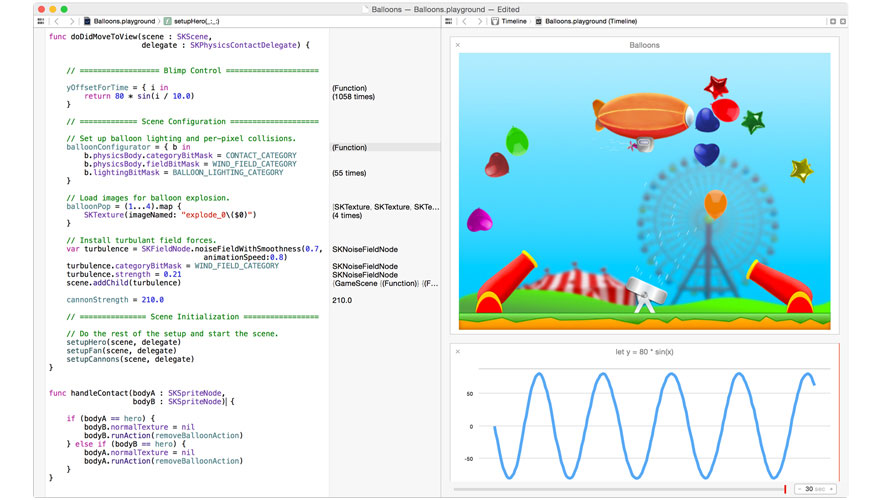 At the Apple Worldwide Developers Conference 2014, one of the biggest reaction from developers didn't come from any new shiny product that Apple is known for. The news about Apple's new programming language, Swift, got appreciation from thousands of the conference's attendance.
At the Apple Worldwide Developers Conference 2014, one of the biggest reaction from developers didn't come from any new shiny product that Apple is known for. The news about Apple's new programming language, Swift, got appreciation from thousands of the conference's attendance.
"We have a new programming language. The language is called Swift, and it totally rules," said Apple's Vice President Craig Federighias.
Apple has used Objective-C as its programming language of choice for Macs since the launch of OS X, and for iPhones and iPads from the very beginning. And the introduction of a new programming language is just showing another bright future for developers.
Swift, introduced in June 2nd, 2014 at WWDC 2014, is how Apple describes "Objective-C without the C." With Swift, Apple wants developers to easy pick up previous apps built with Objective-C and develop it with Swift smoother and faster. According to Apple, Swift can be used to develop any apps, including social networking apps and 3D games.
Swift should be familiar to developers that are already used to Objective-C, Apple says, and is meant to "unify the procedural and object-oriented portions of the language."
Swift can make developers work easier by making it run alongside Objective-C and C in the same application. The language is designed for safety, with variables that have to be initialized before use, arrays and integers that are checked for overflow and automatic memory management.
Swift support is deeply integrated into Apple's updated Xcode IDE. It also provides "playground" feature that enables a preview of the apps while being programmed.Swift may also make life easier for developers in a number of ways, one of which is a "playground" feature that provides a preview of what's being programmed in real-time. This creates a solution where developers can see what they do without the lengthy and denting task of compiling. Theoretically, this means that developers can create concepts faster and develop apps in less time.

Chris Lattner, Apple's director of developer tools, demoed how quickly the language can be tested. He wrote a few lines of code in Swift that assigned values of a variable to the position of a blimp in his demo development environment, and the app was instantly able to show the blimp moving. No building or compiling was required.
The new programming language borrowed some of the best elements from languages like JavaScript and Python. Since these languages are modern and popular among developers, Swift can be easier to learn.
Swift is native to Apple's Cocoa and Cocoa Touch frameworks on which OS X and iOS are respectively built. Federighi outlined the company's ambitious goal to replace the Objective-C and Python languages with a single language that is faster and easier to code in. It promises to blaze past Objective-C and Python, with complex object sort 3.9 times faster and RC4 encryption 220 times faster than Python.
The drawback of borrowing elements from other languages is speed. However, Apple thinks that this is not a major concern.
"Swift is an innovative new programming language for Cocoa and Cocoa Touch. Writing code is interactive and fun, the syntax is concise yet expressive, and apps run lightning-fast," said Apple in its website. "From its earliest conception, Swift was built to be fast. Using the high-performance LLVM compiler, Swift code is transformed into optimized native code, tuned to get the most out of modern Mac, iPhone, and iPad hardware."
Here are some of the highlights of the language according to Apple:
- Closures (similar to blocks in C and Objective-C) unified with function pointers.
- Tuples and multiple return values.
- Generics.
- Fast and concise iteration over a range or collection.
- Structs that support methods, extensions, protocols.
- Functional programming patterns, e.g.: map and filter.
During the conference, Apple released a Swift guidebook to the iTunes Store - a move that shows how eager Apple is with introducing its new programming language to developers.
Swift promises to be employing the best of C and Objective C without its compatibility restrictions. It also promises to put an end to the "infinite loop" errors.
Although there have been quite a lot of programming languages introduced in recent years, including Go, Dart, Rust, and TypeScript, developers have have found it difficult to rely on. Some developers also concerned because Apple opted to develop a proprietary language instead of choosing a more open platform.
But judging from the audience, Swift did capture the enthusiastic developers' attention. This could be an indicator that Swift will succeed where other languages have failed in getting sufficient traction.
